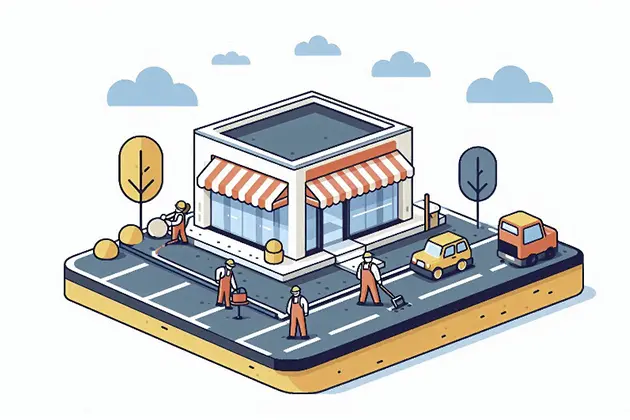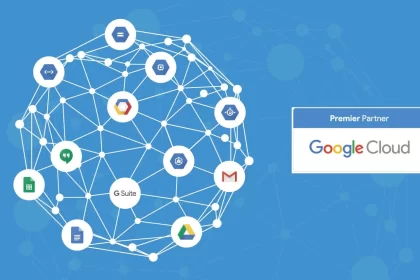Infrastructure is one of the core tenets of business success. It encompasses buildings and everything supporting them, from parking lots and sidewalks to roads and beyond.
There are several reasons for this, so stick around and we’ll give you the lowdown on the multifaceted role infrastructure plays in boosting emerging organizations.
The Importance of Accessibility in Attracting Customers
Accessibility is central to customer experience. If people can’t easily reach your business, they won’t visit it, no matter how great your product or service is.
Key elements of accessible infrastructure include:
- Smooth parking lots and driveways for easy entry and exit
- Clear signage guiding visitors to your location
- Walkways free from obstacles for safe foot traffic
To illustrate this point, imagine a shopper driving by two stores—one with clear access and the other buried behind potholes and unclear directions. They’ll likely choose the first store because it’s less hassle to navigate.
Good accessibility improves convenience for all customers, including 70+ million people with disabilities or mobility challenges. Businesses investing in this aspect create positive impressions that build loyalty over time.
How Parking Lot Design Reflects Your Brand Identity
Parking lots set the tone for your brand before customers walk through the door. A clean, well-designed lot communicates professionalism and care, while a neglected one can imply disorganization.
A parking lot will stand out for the right reasons thanks to:
- Clearly marked spaces that maximize convenience for visitors
- Accessible parking spots located close to entrances
- Smooth pavement free of cracks or potholes
This matters because the parking lot is often the first thing customers see when arriving at your business. If it looks inviting and orderly, it will leave them with a favorable impression.
Beyond appearance, an efficient layout minimizes traffic confusion during busy times, making visits smoother overall. These details might seem small, but they directly influence how customers perceive your company’s attention to detail and reliability.
Walkways and Sidewalks for Safety and Compliance
Walkways are another infrastructural aspect that will ensure safety for customers and employees alike. Neglecting these areas can lead to tripping hazards, liability risks, or poor first impressions.
Essential factors for safe and appealing walkways include:
- Smooth surfaces without cracks or uneven spots
- Proper drainage to prevent pooling water after rain
- Adequate lighting for visibility during nighttime hours
Partnering with trusted contractors is critical. For example, working with a reputable provider of paving in New Jersey to repair or install sidewalks ensures durable materials and compliance with local standards.
Investing in high-quality walkways enhances safety and elevates the overall customer experience. Thoughtful design choices like incorporating ramps or textured paths show inclusivity while reducing potential risks, creating a welcoming space everyone can enjoy confidently.
Why Road Conditions Lead to Revenue
The state of nearby roads has a direct impact on your business. If access is difficult or unpleasant, potential customers may choose competitors with easier routes.
Road conditions influence customer behaviour in several ways. For example:
- Smooth and well-maintained roads encourage repeat visits
- Clear markings reduce confusion and improve traffic flow
- Potholes or poor signage create frustration and deter drivers
Put simply, nobody wants to endure unnecessary wear and tear on their vehicle just to shop or dine with your business. As such, advocating for better local infrastructure, whether through community initiatives or partnerships with city planners, can lead to long-term growth. Companies located in areas with accessible roads are more likely to attract higher footfall and forge stronger connections within the community over time.
Leveraging Smart Technology for Modern Infrastructure Needs
Technology transforms how businesses approach infrastructure. From design to maintenance, smart solutions make processes efficient and cost-effective.
Smart technology enhances infrastructure via:
- Sensors that monitor wear and tear in real time for proactive repairs
- Automated lighting systems that improve energy efficiency and safety
- Digital tools that optimize traffic flow and parking space utilization
These advancements streamline operations while elevating customer experiences. For instance, parking apps guide drivers directly to available spots, reducing frustration during peak hours. Anyone who’s keen to make waves as an entrepreneur, or simply grow an established organization, must take note of strategies like this.
Wrapping Up
Investing in infrastructure delivers functional spaces that also shape customer experiences, enhance safety, and reflect your brand’s values. Prioritizing quality upkeep and thoughtful design drives growth by making businesses accessible, welcoming, and efficient.
It’s also a means of putting your company on the path to sustainable success.










